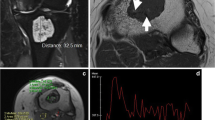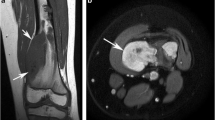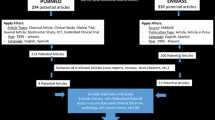Abstract
Objective
To assess if diffusion-weighted MRI (DWI) can differentiate between central enchondromas and chondrosarcomas (CS) and if DWI can distinguish low-grade chondroid lesions from high-grade CS.
Materials and methods
Fifty-two patients with central cartilage tumors were included. Patients underwent conventional MRI and DWI with ADC mapping. The slice on MRI with the most aggressive imaging feature was identified. The corresponding mean and minimum ADC maps of the tumor at this position were measured.
Results
There were 24 enchondromas, five atypical cartilaginous lesions, 15 grade 1, three grade 2, two grade 3, and three dedifferentiated CS. Mean ADC values (×10−6 mm2/s) for enchondromas, atypical cartilaginous tumors, grade 1 CS, grade 2, CS, grade 3 CS and dedifferentiated CS were 1,896, 2,048, 2,152, 2,170, 2,076, and 1,261, respectively. Minimum ADC values (×10−6 mm2/s) for enchondromas, atypical cartilaginous tumors, grade 1 CS, grade 2, CS, grade 3 CS and dedifferentiated CS were 1,820, 1,752, 2,010, 1,829, 1,752, and 767, respectively. ANOVA test demonstrated a statistically significant difference in mean and minimum ADC values in all groups. Post hoc analysis revealed this was due to difference in mean and minimum ADC values in dedifferentiated CS. The mean ADC value in low-grade chondroid lesions was 2,001, while the ADC value for high-grade CS were 2,132. The minimum ADC value for low-grade chondroid lesions was 1,896, while the minimum ADC for high-grade CS was 1,837. The difference in minimum and mean ADC values was not statistically significant.
Conclusions
DWI cannot differentiate between enchondromas and CS and DWI does not aid in the distinction of low-grade chondroid tumors from high-grade CS.





Similar content being viewed by others
References
Hogendoorn PCW, Bovee JVMG, Nielsen GP. Chondrosarcoma. In: Fletcher CDM, Bridge JA, Hogendoorn PCW, Mertens F, editors. World Health Organization classification of tumours of soft tissue and bone. Lyon: IARC Press; 2013. p. 264–8.
Walden MJ, Murphey MD, Vidal JA. Incidental enchondromas of the knee. AJR Am J Roentgenol. 2008;190:1611–5.
Hong ED, Carrino JA, Weber KL, Fayad LM. Prevalence of shoulder enchondromas on routine MR imaging. Clin Imaging. 2011;35:378–84.
Douis H, Saifuddin A. The imaging of cartilaginous bone tumours. II. Chondrosarcoma. Skeletal Radiol. 2013;42:611–26.
Reliability of histopathologic and radiologic grading of cartilaginous neoplasms in long bones. Skeletal Lesions Interobserver Correlation among Expert Diagnosticians (SLICED) Study Group. J Bone Joint Surg Am 2007; 89: 2113–2123.
Koh DM, Collins DJ. Diffusion-weighted MRI in the body: applications and challenges in oncology. AJR Am J Roentgenol. 2007;188:1622–35.
Khoo MM, Tyler PA, Saifuddin A, Padhani AR. Diffusion-weighted imaging (DWI) in musculoskeletal MRI: a critical review. Skeletal Radiol. 2011;40:665–81.
Hayashida Y, Hirai T, Yakushiji T, Katahira K, Shimomura O, Imuta M, et al. Evaluation of diffusion-weighted imaging for the differential diagnosis of poorly contrast-enhanced and T2-prolonged bone masses: initial experience. J Magn Reson Imaging. 2006;23:377–82.
Yakushiji T, Oka K, Sato H, Yorimitsu S, Fujimoto T, Yamashita Y, et al. Characterization of chondroblastic osteosarcoma: gadolinium-enhanced versus diffusion-weighted MR imaging. J Magn Reson Imaging. 2009;29:895–900.
Stratta M, Robba T, Clementi V, Regis G, Gallo A, Piana R, et al. DWI in the differential diagnosis of enchondroma and central chondrosarcoma. Skeletal Radiol. 2012;41:1179–87.
Grimer RJ, Carter SR, Tillman RM, Mangham DC, Abudu A, Fiorenza F. Chondrosarcoma of bone. J Bone Joint Surg Am. 2000;82-A:1203–4.
Douis H, Singh L, Saifuddin A. MRI differentiation of low-grade from high-grade appendicular chondrosarcoma. Eur Radiol. 2014;24:232–40.
Inwards C, Hogendoorn PCW. Dedifferentiated chondrosarcoma. In: Fletcher CDM, Bridge JA, Hogendoorn PCW, Mertens F, editors. World Health Organization classification of tumours of soft tissue and bone. Lyon: IARCP; 2013. p. 269–70.
Murphey MD, Flemming DJ, Boyea SR, Bojescul JA, Sweet DE, Temple HT. Enchondroma versus chondrosarcoma in the appendicular skeleton: differentiating features. Radiographics. 1998;18:1213–37. quiz 1244–1215.
Eefting D, Schrage YM, Geirnaerdt MJ, Le Cessie S, Taminiau AH, Bovee JV, et al. Assessment of interobserver variability and histologic parameters to improve reliability in classification and grading of central cartilaginous tumors. Am J Surg Pathol. 2009;33:50–7.
Verdegaal SH, Brouwers HF, van Zwet EW, Hogendoorn PC, Taminiau AH. Low-grade chondrosarcoma of long bones treated with intralesional curettage followed by application of phenol, ethanol, and bone-grafting. J Bone Joint Surg Am. 2012;94:1201–7.
Rizzo M, Ghert MA, Harrelson JM, Scully SP. Chondrosarcoma of bone: analysis of 108 cases and evaluation for predictors of outcome. Clin Orthop Relat Res. 2001;391:224–33.
Subhawong TK, Jacobs MA, Fayad LM. Diffusion-weighted MR, imaging for characterizing musculoskeletal lesions. Radiographics. 2014;34:1163–77.
Hanna SA, Whittingham-Jones P, Sewell MD, Pollock RC, Skinner JA, Saifuddin A, et al. Outcome of intralesional curettage for low-grade chondrosarcoma of long bones. Eur J Surg Oncol. 2009;35:1343–7.
Donati D, Colangeli S, Colangeli M, Di Bella C, Bertoni F. Surgical treatment of grade I central chondrosarcoma. Clin Orthop Relat Res. 2010;468:581–9.
Yoo HJ, Hong SH, Choi JY, Moon KC, Kim HS, Choi JA, et al. Differentiating high-grade from low-grade chondrosarcoma with MR imaging. Eur Radiol. 2009;19:3008–14.
Messiou C, Collins DJ, Morgan VA, Desouza NM. Optimising diffusion weighted MRI for imaging metastatic and myeloma bone disease and assessing reproducibility. Eur Radiol. 2011;21:1713–8.
Conflict of interest
There is no conflict of interest to declare.
Author information
Authors and Affiliations
Corresponding author
Rights and permissions
About this article
Cite this article
Douis, H., Jeys, L., Grimer, R. et al. Is there a role for diffusion-weighted MRI (DWI) in the diagnosis of central cartilage tumors?. Skeletal Radiol 44, 963–969 (2015). https://doi.org/10.1007/s00256-015-2123-7
Received:
Revised:
Accepted:
Published:
Issue Date:
DOI: https://doi.org/10.1007/s00256-015-2123-7




